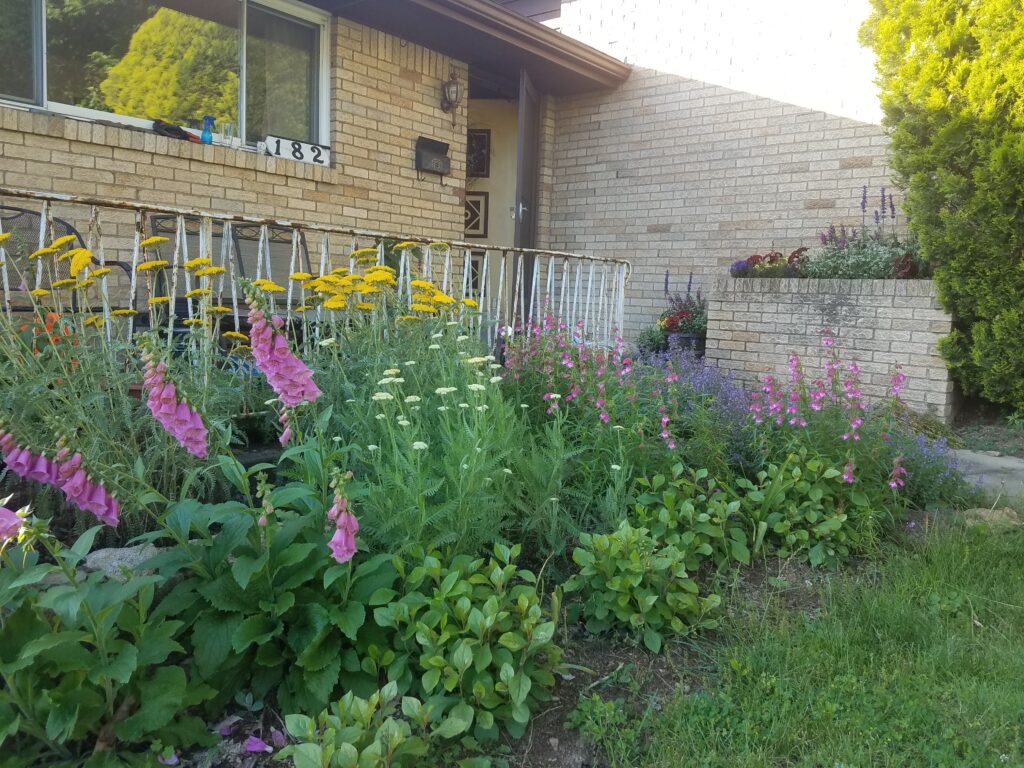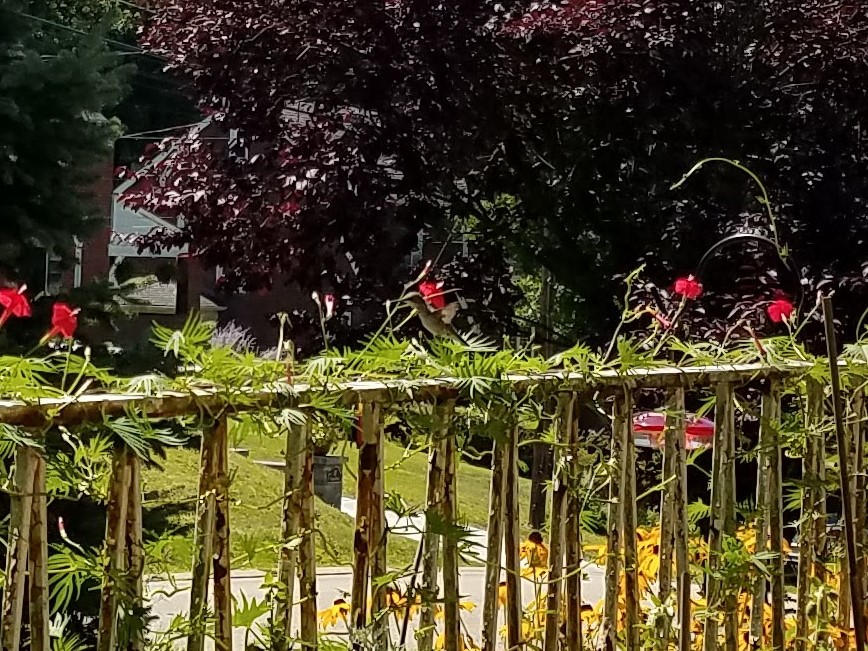Hummingbirds have brought me immense, if fleeting, joy for several years now as my pollinator garden has grown. The first time I got buzzed by one I was digging in the dirt and thought it was an extremely large carpenter bee. Once I realized what it was, I was overjoyed that I had received my first ever hummingbird visitor. Whether it’s to my feeder or to my flowers, I am filled with pride that these amazing little creatures have deemed my garden worthy to visit.
I hadn’t thought to write a post on hummingbirds until, much to my dismay, I saw some deadly misinformation circulating on my neighborhood’s message board app. Since they are so tiny, their bodies are incredibly sensitive to what they consume. Pesticides, herbicides, and even some hummingbird nectars contain chemicals that can hurt or kill them. Below is information that can help ensure the health and safety of your beautiful neighborhood hummingbirds.
Nectar
The internet comment in question was from a woman in my neighborhood whose name happens to be Karen. She mentioned multiple times in the conversation thread that she likes to put red food coloring in her hummingbird nectar to attract them. Several people informed her not to do this because it is toxic, but she held firm to her belief that it was fine, saying she had been doing it for years.

As it happens, there is no scientific proof that Red #40 (the coloring agent included in some commercial nectars) is harmful to hummingbirds; there is also no proof that it isn’t – no research has been conducted on hummingbirds specifically. It has been tested on rats and mice, and in both cases has shown to increase incidences of tumors, both internal and epidermic. A master hummingbird bander (someone who puts the delicate little metal bands on the even more delicate little hummingbird legs) in Louisiana measured dye quantities coming from a feeder and determined that hummingbirds were ingesting the equivalent of 17 times the daily recommended quantity for humans, and 12 times higher than the equivalent dose that resulted in DNA damage in mice.[1]
Commercial nectars can contain unnecessary (at best) or potentially harmful (at worst) additives, so it is best to simply make your own from scratch, which is incredibly easy to do:
- 1 part white cane sugar
- 4 parts water
That’s all you need. Boil the mixture and let it cool. Excess nectar can be stored in the fridge for up to a week. Nectar should be changed every four or five days when the temperature is under 90F. When it’s hotter out, you will need to change it more frequently. Watch the liquid and change it before it gets cloudy.
Empty and wash the feeder with a mild detergent between fillings, making sure to clean the ports too. Black residue is mold and must be completely removed. Once a month, soak the feeder in a mild bleach solution (1 Tbs bleach, 1 qt water) and rinse very thoroughly.
Information beyond these basics (covering predators, pests, territory, and more) can be found at websites for support organizations such as The Hummingbird Society.[2]
Pesticides
Hummingbirds don’t only feed at the feeder, though. Their diet consists of nectar, which they can also get from flowers, and small insects, which can be attracted and supported by a healthy, organic garden. I’ve been thrilled to watch mine making their way through my garden too, particularly to red, tubular blossoms. Mine always seem to go straight for my foxgloves, salvia, and cardinal climber vine. There are plenty of flowers you can plant for hummingbirds in the area, and you can find an informative list at the Farmer’s Almanac.[3] However, it is very important that when you plant these flowers, you make sure they are hummingbird-safe, by which I mean pesticide-free.

Similar to the monarch butterfly post from a few weeks ago, some hummingbird populations appear to be in decline, such as the Rufous Hummingbird, which has seen a total population reduction of 62% from 1966 to 2014.[4] Several of the factors leading to this decline include “habitat loss, climate change, and fragmentation of breeding grounds.”[5]
New research points to a specific type of insecticide that could also be contributing to hummingbird decline. Neonicotinoids (pronounced NE-o-ni-COT-in-oids), or neonics, are a type of insecticide that persist in soil and water for months or years. Neonics don’t just sit on the outside of the plant as a residue, but travel throughout the entire plant and can be found in the roots, stems, leaves, pollen, and nectar. Neonics are used on commercial crops, but also in insect-resistant plants frequently sold at big-box garden centers, and even in some flea and tick medications for cats and dogs. Just because you’re not spraying pesticides in your garden does not mean your hummingbirds are necessarily safe. It requires a little more digging.

Several studies have shown that neonics are toxic to birds, with even small amounts resulting in death or reduced ability to reproduce.[6],[7] One hummingbird-specific study measured neonics levels in hummingbirds. The birds typically ingest it by eating insects and sipping nectar from pesticide-treated plants.[8],[9]
What to Do?
As sad as it is to think of these beautiful birds being harmed uknowingly by us, there are several steps you can take to help them, both at home and in the larger political sphere:
- Make your own hummingbird nectar and change it frequently.
- Plant hummingbird-friendly flowers.
- Don’t use pesticides that contain neonicotinoids/neonics.
- Don’t buy plants that have been treated with neonicotinoids – always ask before you buy anything. Support small, local, organic garden centers whenever you can – they will be less likely to carry neonics-treated plants, and their employees will be better able to answer your questions anyway.
- Talk to your neighbors about the dangers of neonicotinoids – just because your yard is safe doesn’t mean your neighbors’ are too.
- Talk to your local big-box garden centers and demand that they stop carrying pesticides containing neonics and plants treated with neonics.
- Talk to your local elected officials and urge them to expand protections for pollinators, including bans on neonicotinoid use. Federal-level examples include the “Saving America’s Pollinators Act”[10] and the “Pollinator Recovery Act.”[11]
- Contribute time and/or money to advocacy organizations that have greater lobbying power and raise awareness of the issue on a larger scale.[12]
Do you have any hummingbird stories? I’d love to hear about them below – what kind you have, what plants they prefer, and how bold they are.
Thank you for reading – and happy bird watching!
[1] https://www.birdwatchersdigest.com/bwdsite/learn/hummingbirds/red-dye-hummingbird-nectar.php
[2] https://www.hummingbirdsociety.org/feeding-hummingbirds/
[3] https://www.almanac.com/content/plants-attract-hummingbirds
[4] https://www.allaboutbirds.org/guide/Rufous_Hummingbird/lifehistory
[5] https://medium.com/@foe_us/the-birds-and-the-bees-new-research-implicates-pollinator-toxic-pesticides-in-hummingbird-declines-a733ef6023cb
[6] https://abcbirds.org/article/birds-bees-and-aquatic-life-threatened-by-gross-underestimate-of-toxicity-of-worlds-most-widely-used-pesticide-2/
[7] https://abcbirds.org/article/birds-bees-and-aquatic-life-threatened-by-gross-underestimate-of-toxicity-of-worlds-most-widely-used-pesticide-2/
[8] https://vancouversun.com/news/local-news/insecticide-blamed-for-decline-of-b-c-hummingbirds/
[9] https://www.researchgate.net/profile/Christine_Bishop2/publication/326213486_Hummingbirds_and_bumble_bees_exposed_to_neonicotinoid_and_organophosphate_insecticides_in_the_Fraser_Valley_British_Columbia_Canada/links/5b454c06aca272dc385f529a/Hummingbirds-and-bumble-bees-exposed-to-neonicotinoid-and-organophosphate-insecticides-in-the-Fraser-Valley-British-Columbia-Canada.pdf
[10] https://www.congress.gov/bill/116th-congress/house-bill/1337
[11] https://www.merkley.senate.gov/news/press-releases/during-national-pollinator-week-merkley-unveils-new-proposal-to-help-restore-pollinator-populations-across-the-us
[12] https://medium.com/@foe_us/the-birds-and-the-bees-new-research-implicates-pollinator-toxic-pesticides-in-hummingbird-declines-a733ef6023cb
0 Comments